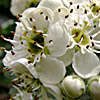Crataegus azarolus (Azarole Hawthorn) is a low tree, up to 8 m. It is winter-deciduous and branched. The young branches are felty, with a brown bark and a thorny tip. The leaf is triangular-cunate, and its base narrows gradually towards the petiole. Its end is cleaved into 3-5 lobes. It is 3-5 cm long, and its texture is rather leathery. The leaves sprout in March and are shed in October. The tree is very similar to the common Spiny Hawthorn. The easy and sure way to differentiate between them is by the color of the fruit only.
Azarole Hawthorn blooms in April and May, a short time after the sprouting of the leaves. The flowers are white, typical of the Rosaceae (similar to those of apples, pears, and plums), and are arranged in dense clusters of 5-10 flowers. Sometimes, an entire tree is covered with refreshing bloom. The calyx is campanulate, and its five lobes are rolled back. The corolla has 5 separate rounded leaves. It has a diameter of 1.5 cm and contains 2 styles and 5-25 stamens. The ovary is inferior, embedded. The fruit ripens in October-November. It is tasty, juicy, red, and is shaped like a perfect sphere. It has a diameter of 1.3 cm and contains 1-3 seeds, usually 2. It is sold in the markets of Damascus. The tree is prominent in the landscape in the autumn, when it is covered entirely with bright red fruits. The seeds are dispersed by birds that eat the fruits.
Azarole Hawthorn grows in a humid Maqui of Quercus calliprinos (Palestine oak) and Quercus boissieri (Boissier oak). It is rather rare, grows on the heights of the Upper Galilee, at an altitude of 800 m, mainly around Mount Adir. Some claim that individuals are also found in the Golan Heights, the Lower Galilee, and Mount Carmel, but this seems to be a mistake. Its global distribution spreads over the countries of the East Mediterranean.
The genus Crataegus contains 200 species, which grow mainly in northern temperate regions on both sides of the Atlantic Ocean, especially in North America, where they are called by different folk names in English. There are 4 species in Israel: Spiny Hawthorn, which is common and has yellow fruits, and 3 rare species whose fruits are red, and which are difficult to differentiate from each other. When there are no fruits, it is difficult to differentiate them from the Spiny Hawthorn.
Written by Mike Livne




